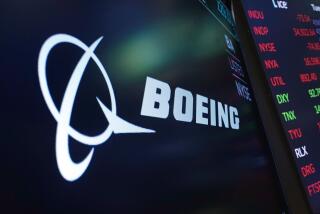Hughes Aircraft Asks $1 Billion From U.S. Over Satellite Patent
- Share via
In the first day of what was described as the largest patent infringement trial ever, Hughes Aircraft claimed Tuesday that the federal government stole a key satellite design that eventually became the basis for a world revolution in communications technology.
The Los Angeles-based aerospace company is seeking damages of $1.2 billion from the federal government in U.S. Claims Court. The trial, the final phase of a 17-year legal dispute, opened in a courtroom at the U.S. 9th Circuit Court of Appeals in Pasadena.
Hughes has already won two previous trials, in which federal courts upheld Hughes’ claim to a valid patent on the satellite device and then ruled that the government had infringed on it.
The current trial, which involves the penalty portion of the complex legal case, is expected to go on for six to nine months. Hughes attorney Sheldon Karon of Chicago said the amount of damages sought is a record.
“This dwarfs anything before it,” Karon said. “There has been nothing that even approaches it.” If Hughes wins the $1.2 billion it seeks, it would be the largest award for patent infringement ever made. But a current case that Polaroid has brought against Kodak could also reach the billion-dollar level and might be trebled under certain circumstances. Under patent law, damages awarded against the government cannot be trebled.
Justice Department attorneys Tuesday sharply disputed Hughes’ claims.
“It is overstated by many, many, many millions of dollars,” Thomas J. Byrnes, the Justice Department attorney representing the government, said in an interview. He added that the Justice Department recently filed a motion for a new trial on the portions of the case that upheld the patent and that found the government infringed on the patent.
At issue is a patent granted to Hughes for a simple way of controlling satellites in orbit. The device was the invention of Donald D. Williams, a young, Harvard-educated physicist on Hughes’ staff in the 1960s.
“The guy was a genius,” A. W. (Tony) Karambelas, Hughes’ staff vice president for patents and licensing, said during a recess at the trial. “We will introduce evidence that over 100 satellites have used this Williams’ patent.”
The crux of the case is the allegation that the Air Force appropriated the Williams’ patent for use on military satellites produced by other contractors, such as Ford Aerospace, TRW and Rockwell International, Karambelas said. Those companies are protected by the government against patent-infringement actions, but Hughes alleges that it was never compensated by the government for its invention.
At Tuesday’s court session, Albert Hibbs, a former scientist at the Jet Propulsion Laboratory in Pasadena, testified about the critical importance of the Williams’ invention in allowing satellites to be controlled in orbit.
The Williams’ device involved use of a single rocket thruster, the firing of which could be precisely timed to stabilize and control the position of a spinning satellite. By firing the thruster in timed pulses, it could accomplish what otherwise would require a heavier system.
To explain the concept to Claims Court Judge James T. Turner, a videotape was used showing a computer simulation of a satellite in orbit. Justice Department attorneys objected to the demonstration, saying that a computer simulation does not amount to “substantive evidence.” Turner took the objection under advisement and said he would rule later.
Williams died in January, 1966, nearly a decade after his invention had revolutionized communications technology, without gaining wide recognition for his accomplishments. But an account of his work in the Hughes Aircraft employee newspaper noted that he once volunteered his life savings to the company when funding for his satellite work was jeopardized.
“When he put that check down on my desk, I became convinced that this type of dedication just has to be supported,” Hughes Aircraft General Manager Pat Hyland was quoted as saying.
On Friday, the court will convene at Hughes Aircraft’s Space & Communications Group’s satellite facility in El Segundo, where Hughes Aircraft Chairman Albert Wheelon will testify.
More to Read
Inside the business of entertainment
The Wide Shot brings you news, analysis and insights on everything from streaming wars to production — and what it all means for the future.
You may occasionally receive promotional content from the Los Angeles Times.











